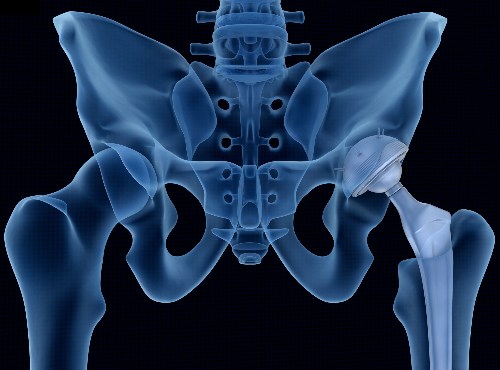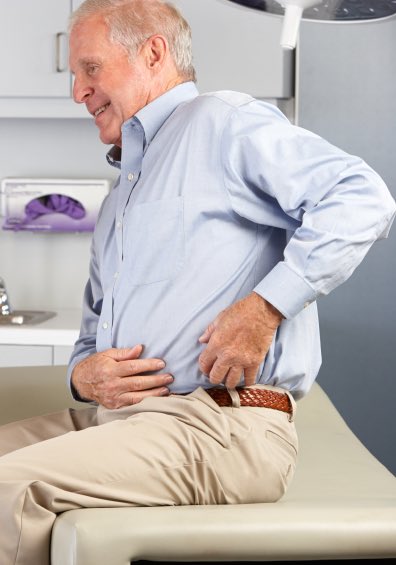What is a total hip replacement?
A total hip replacement is a common procedure to replace a diseased or severely injured hip joint.
The most common reasons for a total hip replacement may include:
Severe arthritis
Physical trauma (dislocation or hip fracture)
Osteoporosis
Rheumatoid arthritis
Source Arthritis Foundation

Hip replacement
To repair the joint, a new ball and socket are placed into the old joint.
The old socket is burred away using a specifically shaped instrument and a metal socket is then placed securely into the newly prepared bone space.
The old arthritic ball of the hip joint is removed and replaced with a new metallic ball. The metallic ball is fixed to a stem that is securely fitted into the centre of the thigh bone.
The stem is fixed in two different ways:
Cementless fixation – If patients are younger than 75 years, the stem may be fixed by allowing the patients own bone to grow into the stem. This is called “cementless fixation”.
Cement fixation – In patients older than 75 years, the stem is usually fixed with cement. This provides immediate fixation and does not require the patient’s own bone to grow into the stem. As patients get older, the quality of their bone decreases which is why cemented fixation is preferred in older patients.
Hip replacement operation
How long does it take?
A hip replacement operation takes around one and a half hours.
Patients are required to be in theatre around one hour before the procedure starts and remain in the recovery area for approximately one hour after surgery.
Anaesthetic
The safest anaesthetic will be worked out between you and the anaesthetist. Usually this will mean an injection into your back with an anaesthetic that numbs your legs.
During the operation the anesthetist also puts you into a light sleep. At then end of the operation, you will have anaesthetic also injected into the area of the operation to help keep the area numb from pain.
Incision
The incision, placed on the side of the hip, measures between 10-20cm. The bigger the thigh the longer the incision will be.
Usually there is a patch of numbness about the size of a hand just around the incision after the operation. This is because the skin nerves in the area of the incision are cut when the incision is made. The numbness reduces in size afterwards but may not go away completely. It will not affect the function of the hip, and it will become less noticeable with time.
During the operation
A catheter may be placed into the bladder to drain urine. Occasionally, a small plastic drain tube will come up from the operated area to take away old blood that collects there after surgery.
Compression stockings will be used to help keep the blood flowing from the legs to the heart. A triangular shaped pillow is placed between legs to keep the feet apart in the early days after surgery. This is a safe position for the hip to be in to prevent dislocation of the hip joint.
Straight after the surgery, oxygen will be given for a day or so, antibiotics which help to reduce the risk of infection will be given and blood thinners will be given by injection to reduce blood clots.
Potential Complications
Joint Infection – may occur in less than 1% of cases. To minimise this risk, you will be given antibiotics at the time of surgery and for 48 hours afterwards. This is usually given through a drip. If there are special reasons, you may have an antibiotic continued for a longer period. If an infection occurs despite these precautions, you may need to go back to theatre to have the area washed out. Very occasionally, the hip joint may have to be removed and the operation repeated in the future.
Blood Clots – in the legs may occur so this risk is reduced by giving you blood thinners via injection, using compression calf stockings and also a calf or foot massaging device to increase the flow of blood from your legs to your heart. You can help by being mobile as soon as possible.
Pneumonia – sometimes occurs in patients who spend long periods in bed. When you lie down for long periods of time, your lungs collapse and sputum gets trapped in the squashed part of the lungs. You can prevent this by getting up soon after surgery and being as mobile as possible. If you get pneumonia, you will need antibiotics.
Heart Attack, Kidney Failure and Stroke – may sometimes occur. To minimise the risk, all patients will be assessed before surgery and if there are any particular risk factors, these will need to be looked at before surgery to make you as fit as possible. A physician will look after you for this, and also after to make sure you remain as fit as possible. It is important to let your surgeon and physician know if there are any important aspects to your medical history before your surgery.
Nerve and vessel injury – Injuries to major nerves or vessels may occur but are rare. Should these occur, this may result in weakness of the leg. All standard precautions will be taken to prevent this. Should they occur, a specialist may be called to provide advice and management of that specific complication.
Dislocation – is a potential risk after the operation if you get into an unsafe position with your hip. Your physiotherapist will teach you the safe positions. You must not bend over so that your hip is bent beyond 90 degrees for the first 6 months after surgery.
Temperature – It is normal to get a slight temperature after surgery for the first 3-4 days. Usually no treatment is required for this. If the temperature persists, then treatment may be required.
Hip replacement – Post operative recovery
There is a good chance you may be up on your feet the day of surgery. This may seem a little early, but it is important to get the body back to normal as soon as possible. The ward physiotherapist and nurses will help you with this.
Delays in getting up can sometimes cause problems such as pressure sores on buttocks and heels, pneumonia, blood clots and low blood pressure, which can lead to fainting. The physiotherapist and ward staff will help you to start moving again.
Dizziness the first few times of trying to get up from bed is normal. A short rest or movement of your legs will help you to regain your blood pressure. Drinking lots of fluid before you get up will also help.
Your first step is to stand, and if this occurs without problems, then you will walk a few steps with a walking frame. We aim to get you walking with the assistance of crutches as soon as possible. We hope to have you heading home (or to rehab) approximately 2-4 days after surgery.
Discharge & Rehabilitation
Usually, you will be sent home in your own car. If you feel unsure about heading home (e.g. if you live alone), an assessment will be made to see if you should go to Rehabilitation. This assessment is made by the hospital Physiotherapist and an appropriate rehabilitation centre chosen for you.
You will have a post operative appointment scheduled for you 6 weeks after your operation.
Your New Hip
Your new hip will last between 10 and 15 years.
Your hip is likely to last longer if you ensure to not do certain exercises: running, jumping and heavy lifting. Keep in mind, doing a revision surgery is not as simple as the first hip replacement.
HIP REPLACEMENT – MELBOURNE
Professor Peter Choong specialises in hip replacement surgery and consults with patients from all over Melbourne and commonly sees patients from interstate and overseas. He has over 30 years of surgical experience and is a Fellow of the Royal Australasian College of Surgeons. Professor Choong is a distinguished surgical leader who has dedicated his career to improving treatments for musculoskeletal diseases.


